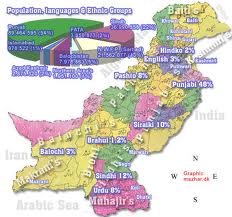Total population
187 million approx.
Regions with significant populations
Primarily Pakistan
Languages
Urdu, Punjabi, Sindhi, Pashto, Balochi, Saraiki and others
Religion
Islam (75-90% Sunni, 10-20% Shia[1][2][3][4][5]) with Hindu, Sikh and Christian minorities
Demographics of Islamic Republic of Pakistan
Population of Pakistan, 1961-2003
Population: 187,343,000 (2011 est.)
Growth rate: 1.6%
Birth rate: 31 births/1,000 population (2009 est.)
Death rate: 8 deaths/1,000 population (2009 est.)
Life expectancy: 63.39 years (2009 est.)
male: 62.4 years (2009 est.)
female: 64.44 years (2009 est.)
Fertility rate: 3.58 children born/woman (2008 est.)
Infant mortality rate: {{{infant_mortality}}}
Age structure:
0-14 years: 36.7% (male 33,037,943/female 31,092,572)
15-64 years: 59.1% (male 53,658,173/female 49,500,786)
65-over: 4.2% (male 3,495,350/female 3,793,734) (2009 est.)
Sex ratio:
At birth: 1.00 male(s)/female (2006 est.)
Under 15: 1.06 male(s)/female (2006 est.)
15-64 years: 1.05 male(s)/female (2006 est.)
65-over: 0.82 male(s)/female (2006 est.)
Nationality:
Nationality: noun: Pakistani
Major ethnic: See Ethnic Groups of Pakistan
Language:
Official: See Languages of Pakistan
Spoken: See List of Pakistani languages by number of native speakers
Pakistan’s estimated population in 2011 is over 187 million making it the world’s sixth most-populous country, behind Brazil and ahead of Bangladesh. While compared to India, Pakistan’s population is less than one Indian state, Uttar Pradesh whose population is 200 million. During 1950-2011, Pakistan’s urban population expanded over sevenfold, while the total population increased by over fourfold. In the past, the country’s population had a relatively high growth rate that has, however, been moderated by declining fertility and birth rates. The population growth rate now stands at 1.6%.
Dramatic social changes have led to rapid urbanization and the emergence of megacities. During 1990-2003, Pakistan sustained its historical lead as the second most urbanized nation in South Asia with city dwellers making up 36% of its population. Furthermore, 50% of Pakistanis now reside in towns of 5,000 people or more.
Pakistan has a multicultural and multi-ethnic society and hosts one of the largest refugee populations in the world as well as a young population.




Comments are closed